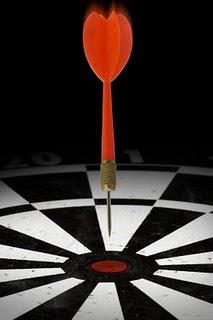
Today we're talking about commotio cordis, a surprising (but not rare) cause of sudden death in athletes. The term commotio cordis comes from Latin, and means "agitation of the heart." This is apt.
A typical scenario might unfold like this....
A teenage pitcher on a high school baseball team makes his pitch and the batter hits the ball back directly at the pitcher. The ball strikes the pitcher in the front of the chest, the pitcher falls to the ground....and doesn't get back up. Bystanders react slowly, but tend to the pitcher and find that he is unconscious. It takes a while for the bystanders to realize the gravity of the situation and they eventually begin CPR when they realize that there is no pulse and the pitcher is not breathing. Eventually, somebody thinks to call 911 and EMS providers arrive on the scene some 15 minutes after the incident. They discover that the patient has an arrhythmia called ventricular fibrillation, but despite attempts at defibrillation (shocking the patient), the pitcher cannot be resuscitated and dies. We hear about the episode in a short report in the local newspaper the next day.
What is Commotio Cordis?
We use the term commotio cordis to refer to an incident where an individual is struck by an object in the chest, causing a fatal arrhythmia. This is a different situation that when an individual suffers major trauma (eg, motor vehicle accident) with significant chest trauma and there is evidence of significant injury (eg, contusion) to the heart. In the case of commotio cordis, the trauma is seeminly minor.
It turns out that commotio cordis is probably the second most common cause of sudden cardiac death in young athletes; only hypertrophic cardiomyopathy is a more common cause.
Who Gets Commotio Cordis?
Most instances of commotio cordis occur in young male athletes who are struck in the chest by a projectile such as a baseball. Direct blows to the chest, as in karate or other martial arts, may also be a cause. Other sports where this condition has been reported include softball, ice hockey, football, and lacrosse.
This condition historically received little attention in the broader public media or scientific community. Recently, though, there was the formation of the U.S. Commotio Cordis Registry to keep track of victims. To date, more than 210 cases have been reported.
Among patients in the U.S. Registry, the majority of athletes with commotio cordis were between 10 and 25 years old; 26% were younger than 10 years of age, and only 9% were older than 25 years old.
Almost 50% of commotio cordis events occur during competitive sporting events. The remainder occur, about equally, in daily activities or in recreational sporting activities.
What Actually Happens to the Heart?
In victims of commotio cordis, the impact of a blunt object on the anterior chest wall leads to ventricular fibrillation, a disorganized rhythm of the ventricles that results in ineffective pumping of the heart, and a marked fall in the blood pressure. We've learned from investigations in animal models that the susceptibility to ventricular fibrillation occurs during a very specific, very short period (perhaps just 20 msec) during the cardiac cycle that corresponds to the initial upstroke of the T-wave on the ECG.
Like the photo at the top, it's like hitting the bullseye, but with a baseball or other flying object. The impact on the anterior chest wall must occur at just the precise moment to produce the fatal arrhythmia.
What's the Treatment?
Commotio cordis is usually fatal. With increasing attention paid to this condition, though, the survival rate has increased from about 15% to about 35% over the past decade.
The only effective treatment for invididuals with ventricular fibrillation due to commotio cordis is prompt defibrillation. We know that survivors have received prompt CPR and defibrillation within the first few minutes after collapsing. The survival rate may be less than 5% for victims in whom CPR/defibrillation is delayed more than 3 minutes.
These statistics point to the importance of bystander CPR and the availability of automatic external defibrillators (AEDs) for use by bystanders before trained medical personnel can arrive on the scene.
How Can We be Better Prepared?
Efforts to reduce the frequency (and mortality associated with) commotio cordis are focused in 3 areas: 1) prevention, 2) better awareness, and 3) prompt, effective treatment.
Because of the variety of mechanisms that are responsible for commotio cordis, it's unlikely that athletes could be told to avoid all situations in which commotio cordis might occur. On the other hand, athletes CAN be instructed to turn the chest when a ball is heading toward them, so that it strikes somewhere other than the anterior chest. And, of course, strict attention can be paid to wearing chest protectors for goalies, baseball catchers, etc.
Better awareness about commotio cordis, particularly among athletes and coaching staffs, might help promote quicker recognition of the problem--and then institution of prompt treatment with CPR and defibrillation. Too often now, bystanders don't recognize the life-threatening nature of an athlete's collapse after being struck, and treatment is unnecessarily delayed.
The report from the 36th Conference on Eligibility Recommendations for Competitive Athletes with Cardiovascular Abnormalities made several recommendations about commotio cordis:
1. Age-appropriate safety baseballs are recommended for use in children up to 13 years of age.
2. Although chest wall protectors may prevent traumatic injury in goalies and baseball catchers, insufficient evidence is available to recommend universal use of commercially available chest barriers for all participants in sports, specifically to prevent commotio cordis events.
3. AED's should be available within 5 min after participant collapse at sporting events.
4. Survivors of a commotio cordis with ventricular fibrillation should undergo a thorough cardiac evaluation, including at least 12-lead ECG, ambulatory Holter monitoring, and echocardiogram.
5. Because data are lacking with regard to the susceptibility for recurrent events, eligibility for returning to competitive sports in survivors is at present a decision left to individual clinical judgment.
